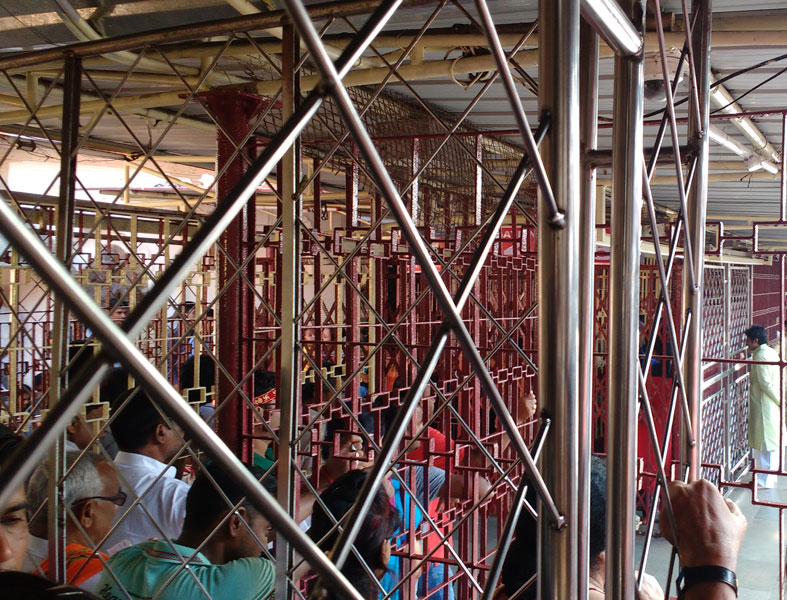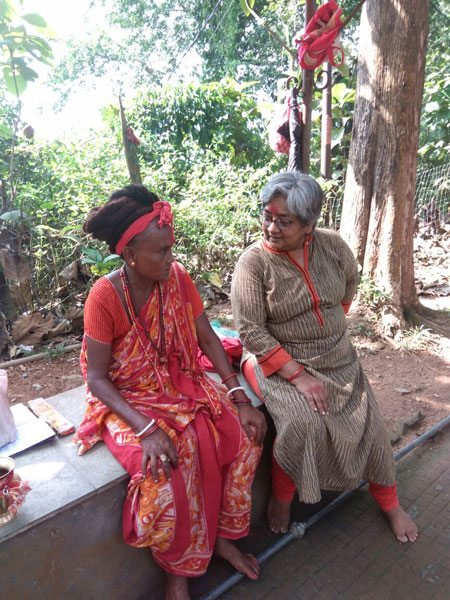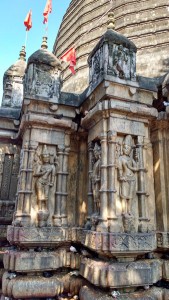
Meet Sita. She moved to Guwahati about ten years ago, from Bengal. In search of better prospects, of course. Her work environment is idyllic, high up on the Nilachal mountainside, surrounded by trees touched by breezes where the quiet is only occasionally broken.

Not too many people come to pay their respects at the abode of goddess Bhuvaneswari here. For most, a visit to the shrine of the powerful Kamakhya a little further down the hill, is experience enough of a lifetime.
Kamakhya is believed to be very powerful, her temple is one of the few where animal sacrifice still persists.
Kamakhya in Guwahati is an important site of Parvati as Sati or Adi Parashakti or Shakti. There’s no physical deity in the sanctum, only a stone slab topped with a cloth in front of which stands a small silver plaque. Walk to the back of this altar and go down a few dark, granite steps into the cave where a priest, the panda, sits by a small depression in the ground. Here, there is a constant, light bubble of water thrusting upward from a well emanating from way inside the mountain.

This is the real shrine of Goddess Kamakhya. You dip your hand in the water and touch it to your lips and eyes and head even as eager worshippers push and pull. The panda paints your forehead with vermillion as he urges you to open your purse strings. Another panda urges you to maatha teko at the waters of Saraswati and Lakshmi. This is followed by unsubtle references to the usual. And then you are gently pushed out into the sun again. Despite yourself, you feel charged, reborn even.
The story of Kamakhya is the story of Shiva and Sati. She is wildly in love with him, much to the displeasure of her father who refuses to accept her choice of life partner. The details of this narrative are easily available online, but the upshot is that Sati is so disoriented by her father’s obdurate attitude, she yells and curses and finally yields up her life. Shiva is heartbroken and wanders mad with grief around the universe, carrying Sati’s body. Somewhere along the way, her body is decapitated — no, it’s not a pretty story — and the various parts begin to fall off at random. Wherever they fall on earth, a Sati or Shakti shrine comes up.
Despite yourself, you feel charged, reborn even.
It is believed that Sati’s vagina fell on this spot, here on Nilachal hill. Therefore, the fissure in the cave floor is interpreted as being the yoni or vulva of the goddess. This is what we worship. The irony cannot be ignored.
Earlier, as we waited in queue in three parallel caged lines, I couldn’t stop my mind from wandering and wondering. Kamakhya is believed to be very powerful, her temple is one of the few where animal sacrifice still persists. A couple of compliant goats, resigned to their fate and marked with blood-red kumkum, sit in the prakara, unmindful of the surging crowds. Kamakhya is an idea in this temple, and what is physically worshipped is the female principle or energy embodied by her yoni. Yet, in the world outside and around — why, possibly even among the people who come to worship her — the very same female principle is desecrated, through despicable gaze and physical abuse. Toddlers, little girls, young women, elderly ladies — no one is spared. They are all equally objects of wanton cruelty and raging rape. The hypocrisy of the situation is palpable and I don’t want to enter the garba griha.
I share these thoughts with my host, Antara. I don’t believe, how can I go in there, I ask. But before I can gather my thoughts, we find ourselves inside the sanctum sanctorum, and there we are allowed to stay for a good many minutes. Then, as I said, we are gently pushed back out into the sun.
Now we will go and see Bhubaneswari, further up the hill, says Antara. They say if you go to Kamakhya, you must also go to Bhubaneswari. That’s where we see Sita, wearing a red sari, hair all matted, eyes a light brown, small teeth flashing. She and her friend are complimenting each other on their saris. “The priest gave it to me,” Sita says, showing paan-stained dental work. “It’s beautiful,” her friend replies. “You look fabulous.” Sita nods, she knows she looks fabulous.
Antara and I smile and carry on, up the steps, to the temple. It is unbelievably serene and cool up there. Like the Kamakhya temple, parts of this temple too are camouflaged by hideous modern architecture. But inside the sanctum, here, too, there is no deity, only a dank stairwell lit by a single oil lamp, with the little opening at the bottom, water gently bubbling. Another yoni, I ask myself, not understanding. However, there’s no panda watching over, no frenetic grabbing and grouching. Just an unattended aarati plate at the entrance. We sound the bells to mark our presence with Bhuvaneswari and turn back.
On the way down, we are drawn to Sita. She’s a friendly sort, willing to chat. This is where she works, sitting patiently, waiting for alms. Some days are good, some not. She’d like to work longer hours, but she has to get home to do the housework. She cooks for the family before coming to the temple. “If I don’t cook how will we eat?” she asks. She has to clean, and keep house, manage the finances… Who else will do it?

Can I have a photo, I ask. Sure, she replies, and pats down her sari pleats. Then, when I press a token of appreciation into her hand, she says, don’t forget my man there. I look down. Which man? There are at least four or five lined up, and a woman, all sitting quietly, waiting, merging with the tranquillity at the top of this hill.
Everyone enjoys the benefit of Sita’s benediction, and we leave with light hearts. For a brief while, the pain of the contradiction is forgotten. We are carried on the wings of Kamakhya’s energy and embraced by the stillness of Bhuvaneswari, queen of the universe. Sita is one with this. That’s why she returns to this cog in the wheel of life, day after day, whether pilgrims come or not.
I want to know: Sita of the matted hair, where do you get your mojo from?
Courtesy: BusinessLine






